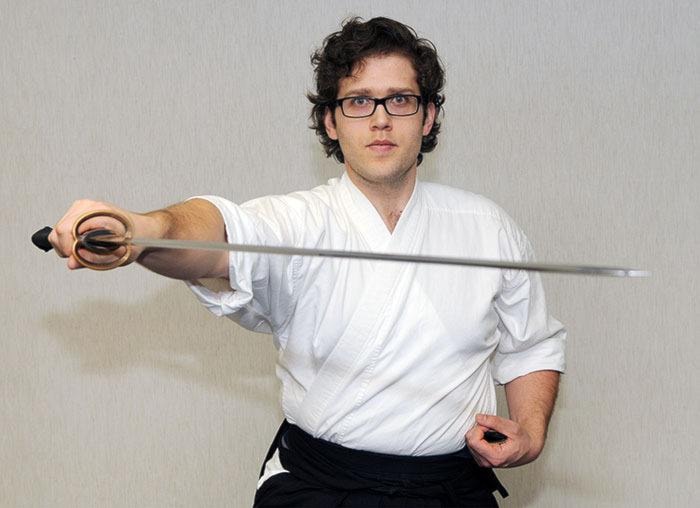Sensei Chris Tooley wants to draw new blood to his samurai swordsmanship class but doesn’t want any spilling on the floor.
Tooley teaches Iaido, a traditional Japanese martial art that is commonly associated with samurai and swords. While it does have a gruesome past, Iaido is practiced as a non-combative art, which exercises the mind, body and spirit, Tooley said.
“I think it’s a very beautiful martial art,” the 31-year old said. “The movements are really precise. It’s not explosive and frantic. Practicing Iaido is a very relaxing thing for me.”
Practicing Iaido requires being at ease and focus. One must be acutely aware of every arm, leg and body motion as it must correspond with the offensive motions of the opponent. The first movement beginners learn is to walk forward to an imaginary opponent, draw the sword, cut across horizontally and then straight down vertically in a precise and efficient fashion.
“You have to imagine the opponent you have to cut, which is kind of gross,” Tooley said. “You have to get past that and think of it as an art.”
The movements become increasingly elaborate and precise as one progresses and that is when the cutting starts to look and feel artistic.
While the samurai warrior class has been around since at least the 10th Century, Iaido in its current form was officially recognized in Japan in 1932. Iaido beginners use a wooden sword known as a bokuto, before graduating to a blunt metal sword called an iaito, to the actual samurai-type sword, known as a katana. However, it is not necessary to move up to the sharper sword – which can easily cost more than $1,000 and weighs one kilogram – as the point of Iaido is movement and artistic practice. A wooden sword costs about $25. One can easily hurt themselves or others with a real sword if the wrong kind is used, as fast, sudden movements can cause the blade to break off, sending it flying across the room.
Tooley was first exposed to Iaido at 16 by watching his father practicing it on the front porch of their home in the Yukon. Enthralled by what he saw, he signed up and has been practicing since.
“I thought, ‘wow, that’s really cool,’” Tooley said. “You get to play with a sword.”
Tooley started teaching Iaido at Monterey Centre on Saturday afternoons earlier this month, he has taught in Saanich nine years. The Iaido he teaches is in line with the style taught in Japan, where he often visits to learn from higher ranking sensei, or teachers.
There is a nominal cost to attend classes, but instructors like Tooley are unpaid as money goes towards renting the facility and to support the non-profit Canadian Iaido Association. The association, which is based in Victoria, is linked to the All Japan Iaido Federation and administers exams and holds seminars in Canada. Tooley is the Canadian association’s treasurer. Sensei from Japan routinely come to Canada to make sure the practice is being taught properly.
Iaido can be practiced by people of all ages, who are encouraged to work within their comfort zone. However, one needs to be in reasonably good health.
“It might not be good if you’ve got problem with your knees,” Tooley said. “Seiza is the traditional Japanese way of sitting and that can be very uncomfortable for people in North America. But that’s fine, you don’t have to sit that way.
“If you have a lot of health issues, it might be quite difficult to do the movements properly.”
To register for a class email iaido.canada@gmail.com or call 250-885-2000. For more information about iaido, go to iaido.ca.
